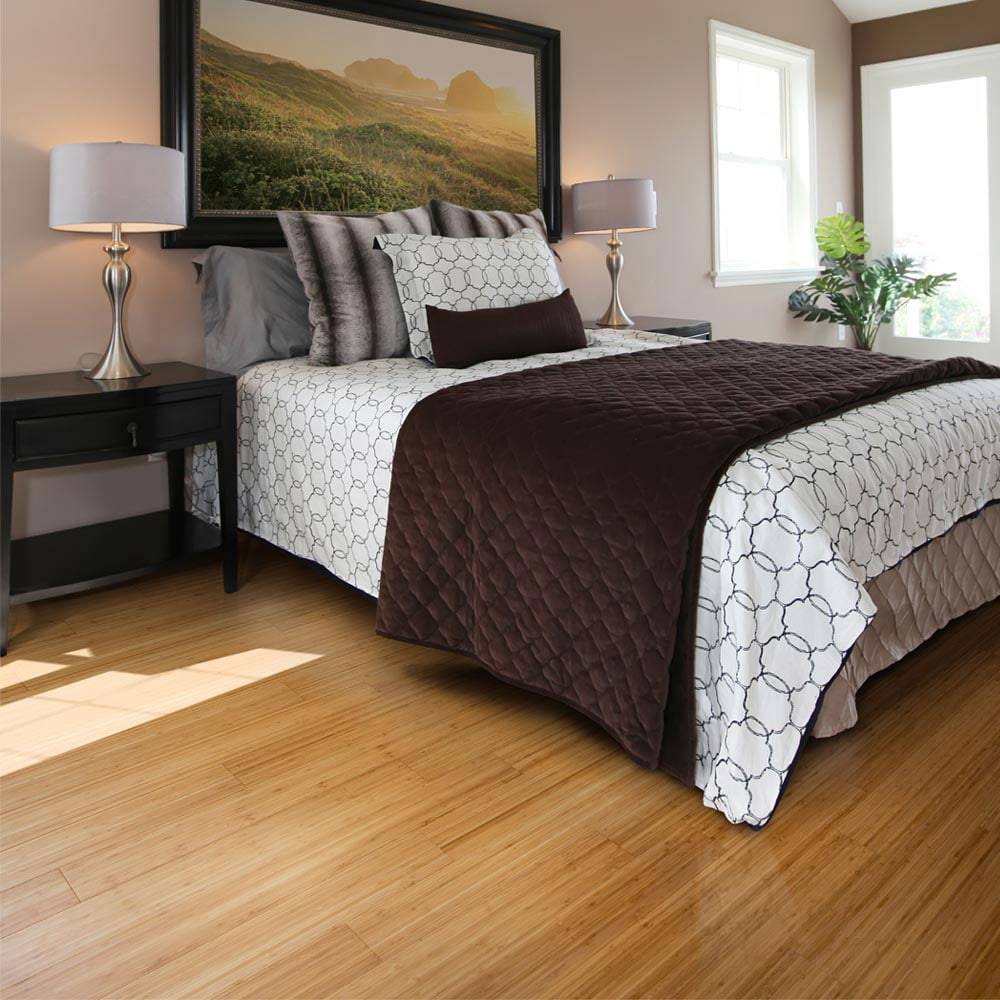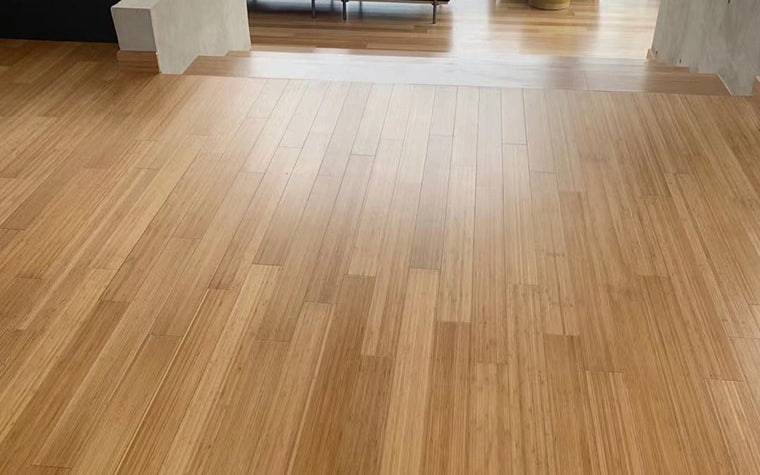Vertical bamboo flooring boasts a distinct and modern look, achieved by gluing thin bamboo strips together vertically, resulting in a sleek, narrow grain pattern. This eco-friendly material offers impressive durability and ease of cleaning, making it ideal for high-traffic areas.
However, it carries a slightly higher price tag and isn’t the best choice for moisture-prone zones like bathrooms. Consider potential scratching as well when making your decision.
Vertical Bamboo Flooring: Weighing the Pros and Cons
Vertical bamboo flooring has become a popular choice for homeowners seeking a unique and sustainable flooring option. It stands out with its distinct visual appeal and boasts several eco-friendly benefits. However, like any material, it has some drawbacks to consider before making a decision.
Pros:
- Unique Aesthetics: The vertical orientation of bamboo strips creates a captivating narrow grain pattern, unlike standard horizontal styles. This adds a touch of modern elegance to any space.
- Eco-Friendly: Bamboo is a fast-growing and renewable resource, making it a more sustainable choice compared to traditional hardwoods.
- Durable and Hardwearing: Despite being a grass, bamboo possesses remarkable strength and resistance to wear and tear, making it suitable for high-traffic areas.
- Easy to Clean and Maintain: Regular sweeping and occasional mopping with a gentle wood cleaner are sufficient to keep your vertical bamboo floor looking its best.
- Dimensionally Stable: Compared to solid wood, vertical bamboo flooring is less prone to warping and shrinking due to humidity changes.
- Refinishable: Similar to hardwood, vertical bamboo floors can be sanded and refinished over time, extending their lifespan and restoring their original luster.
Cons:
- Cost: Vertical bamboo flooring can be more expensive than some other types of flooring, such as laminate or vinyl.
- Susceptible to Moisture Damage: While naturally water-resistant, prolonged exposure to moisture can still lead to warping and swelling. Avoid using it in bathrooms or laundry rooms.
- Prone to Scratches: The surface can be susceptible to scratches from pets, furniture, or high heels. Regular care and protective measures are crucial.
- Limited Color Options: Compared to horizontally oriented bamboo, vertical options have a narrower range of natural color variations.
- Potential for Off-Gassing: Some adhesives used in manufacturing might emit volatile organic compounds (VOCs). Opt for low-VOC or formaldehyde-free options for better indoor air quality.
Overall, vertical bamboo flooring presents a unique and eco-conscious option for homeowners seeking a durable and easy-to-maintain floor. However, its higher cost, moisture sensitivity, and potential for scratching necessitate careful consideration. Therefore, weigh the pros and cons alongside your specific needs and budget to determine if vertical bamboo flooring is the right fit for your home.
Vertical Bamboo Flooring Installation
Installing vertical bamboo flooring follows similar steps as other flooring options, but with important nuances due to its unique composition. Here’s a general overview, but always refer to the manufacturer’s instructions specific to your chosen product:
Preparation:
- Acclimate the planks: Allow the bamboo planks to adjust to the room’s temperature and humidity for at least 48 hours before installation.
- Ensure a level subfloor: Unevenness can lead to problems, so check and address any dips or bumps. Make sure the subfloor is level.
- Lay the underlayment: Use the appropriate underlayment recommended for your specific type of bamboo flooring.
- Gather your tools: You’ll likely need a tapping block, mallet, spacers, pull bar, saw, tape measure, and any specific adhesive required.
Installation:
- Plan the layout: Determine the direction of plank installation and ensure you have enough material, considering waste.
- Start with the first row: Lay the first plank with the groove facing the wall, using spacers for expansion gaps.
- Join the planks: Use the tongue and groove system or click-lock mechanism to connect subsequent planks, tapping them together firmly.
- Cut planks as needed: Use a saw to precisely cut the last plank in each row, maintaining expansion gaps.
- Continue laying rows: Repeat steps 3 and 4, staggering end joints for a natural look.
- Install transitions and moldings: Use appropriate trims to finish edges and doorways.
Additional Tips:
- Use the right adhesive: If your chosen product requires glue, use one specifically formulated for bamboo flooring.
- Work carefully: Avoid damaging the edges and grooves while tapping planks together.
- Maintain expansion gaps: Ensure consistent spacing around walls and obstacles to prevent buckling.
- Clean up thoroughly: Remove dust and debris after installation.
Remember:
- This is a simplified overview. Consult the manufacturer’s instructions for specific details and potential variations depending on your chosen product.
- Consider the complexity and potential for error before tackling DIY installation. If unsure, seek professional help to ensure a successful and long-lasting floor.
Dig Vertical Bamboo Floors? Here’s the Scoop!
Love the look of sleek, modern floors? Vertical bamboo might be your jam! It’s eco-friendly, super tough, and super easy to clean, making it perfect for your busy life. Think spilled coffee? No sweat! Just wipe it up and move on.
But hold on to your yoga mat… This bamboo ain’t cheap. It also hates getting wet, so forget about installing it in the bathroom (sorry, shower singers!). Plus, it can be a bit of a diva when it comes to scratches, so keep those kitty claws trimmed.
So, should you bamboozle your floors? If you’re on a budget or have a menagerie of furry friends, maybe not. But if you’re looking for a unique, sustainable, and low-maintenance option, this bamboo might be your new BFF. Just treat it right!
Vertical Bamboo Flooring: Frequently Asked Questions
What is vertical bamboo flooring?
Vertical bamboo flooring uses thin bamboo strips glued together vertically, creating a unique and narrow grain pattern. It’s known for its modern look, eco-friendliness, durability, and ease of cleaning.
Is it eco-friendly?
Yes! Bamboo is a fast-growing and renewable resource, making it a more sustainable choice than many traditional hardwoods.
Is it durable?
Absolutely! Vertical bamboo flooring is surprisingly strong and resistant to wear and tear, making it suitable for high-traffic areas.
Is it easy to maintain?
Yes, regular sweeping and occasional mopping with a gentle wood cleaner are enough to keep your vertical bamboo floor looking its best.
Is it waterproof?
No, vertical bamboo flooring is moisture-resistant, but not waterproof. Avoid using it in areas prone to moisture like bathrooms or laundry rooms.
Is it prone to scratches?
Yes, the surface can be susceptible to scratches from pets, furniture, or high heels. Regular care and protective measures like area rugs are recommended.
Does it come in different colors?
Compared to horizontally oriented bamboo, vertical options have a narrower range of natural color variations. However, some manufacturers offer stained or carbonized options for a wider selection.
Is it expensive?
Vertical bamboo flooring can be more expensive than some other types of flooring, such as laminate or vinyl.
Can I install it myself?
It depends on your comfort level and DIY skills. While similar to other flooring installations, vertical bamboo requires specific attention due to its unique composition. Always refer to the manufacturer’s instructions and consider seeking professional help if needed.



